Designed for Covenant Relationships

Designed for Covenant Relationships
We are deeply relational beings, designed for love and connection with God and with one another.
By Jenet Jacob Erickson (BS ’97, MS ’00) in the Spring 2023 issue
Illustrations by Eva Vázquez
As a BYU professor of Church history and doctrine with a PhD in family science, I have studied and written extensively about maternal and child well-being as well as the distinct contributions of mothers and fathers in children’s development. Over the years studying family has taken me into the deepest and most dependent, vulnerable, and profound relationships of our lives—and that has brought me to a powerful truth. Though our culture may tell us otherwise, we are not designed for self-actualized, pleasure-seeking autonomy. We are deeply relational beings, designed for radical dependence and connection. Marriage and family life provide a powerful context for us to experience this truth. But they are not just the means to an end. Familial love and belonging are the end.
When I began studying, I marveled as I learned of the foundational role of marriage in binding together man and woman, the powers of procreation, and vulnerable new life. I came to see what University of Virginia professor W. Bradford Wilcox meant when he concluded that “no other institution [than marriage] reliably connects two parents, and their money, talent, and time,”¹ to create the secure and stable environment with nurturing caregivers that children depend on. I observed how healthy marriage benefits men and women, increasing their happiness, mental and physical health, sense of stability, and investment in the future.²
I also witnessed the significant influence of children, reflecting Harvard sociologist Carle C. Zimmerman’s conclusion that it is a society’s orientation to the nurturing of children that defines the “peak of [that civilization’s] creativity and progress.”3 That conclusion gives insight into Kathryn J. Edin’s groundbreaking study of the lives of poor women in inner-city Philadelphia, where in a world of poverty, abuse, drug use, incarceration, and relational trauma and with marriage far out of reach, single mothers felt rescued by their babies, who brought them stability, a place in the world, and a purpose to give their lives for.4 In her later work Edin found that children had the same influence on single fathers.5
I have marveled as I have learned about the complementarity of mothers and fathers in shaping children’s development. A mother is primed to establish a bond through which the emotional communication that is essential for a child’s development can occur. Her infant is also primed to bond with her, already knowing her smell, her voice, and her face. This remarkable relationship appears to shape foundations of identity, sense of well-being, and emotional understanding.

A father’s relationship with a child appears to shape relational capacity, achievement, understanding of boundaries, and emotion management. His closeness offers his daughter a deep experience of what protective male love feels like, strengthening her capacity for wise sexual decisions. His closeness to his son offers an experience with masculinity that is protective and nurturing, not driven by aggression, physical strength, or sexual proclivities.6
I have felt pain as I have learned what happens when men and women, sexual union, and children are broken apart. Perhaps the truth is no more poignantly captured than in the words of Elder Jeffrey R. Holland (BS ’65, MA ’66):
[The sexual union of] a man and a woman is—or certainly was ordained to be—a symbol of total union: union of their hearts, their hopes, their lives, their love, their family, their future, their everything.7
We have seen the disruptive psychological effects of bonding sexually, sharing part without the whole, then severing what was meant to be a total obligation. We witness the pain from nonrelational sexual involvement as others become objects for sexual satisfaction. We see what that has done to the sexualization of women8 and the languishing of men.9 And we see what that fragmentation has meant for children.
Sexual union is designed to create and symbolize a union strong enough that a child’s heart can rely upon it. The fragmentation of marriage has caused a dramatic increase in the number of children born to unmarried parents. Though many of these children manage to grow up without serious problems,10 we also know from hundreds of studies that, on average, children born to unmarried parents face increased risks in every developmental domain.¹¹
Choosing to end a marital relationship that is abusive can be courageous and beneficial, taking children out of a destructive environment. But, in general, division and eventual divorce also mean increased risk—including an experience of inner division and sometimes even exile for a child.¹² Children are, after all, the embodiment of their parents’ union. For a child there is a longing for the original intactness of their being, the loving union of the mother and father from whom they come.¹³
My husband’s parents divorced when he was 6. He can still describe the moment when his mother asked, “Michael, who do you want to live with?”
His 6-year-old heart could not respond. He grew up without religious faith but had deep feelings for Christmas because on that day his parents would come back together to eat breakfast and open presents, and he would feel a wholeness again.
Being for Others
Witnessing the potential for joy and pain in these foundational relationships has confirmed for me that we are deeply relational beings. We are not designed to be autonomous, self-actualized individuals. In the exquisite language of the first and great commandment, we are each “a heart-soul-mind-strength complex designed for love.”14
We come to this earth looking for and dependent on others, “coming most alive when we are in relationships of mutual dependence and trust.”15 Every infant’s primary task is to search out a face—the face that gazes back at them, on whom they fix their eyes. That same infant will someday care for aging parents as the profound cycle of care and dependence continues. For it is in loving and being loved that “we are most fully and distinctively ourselves.”16 This is what we are made for.
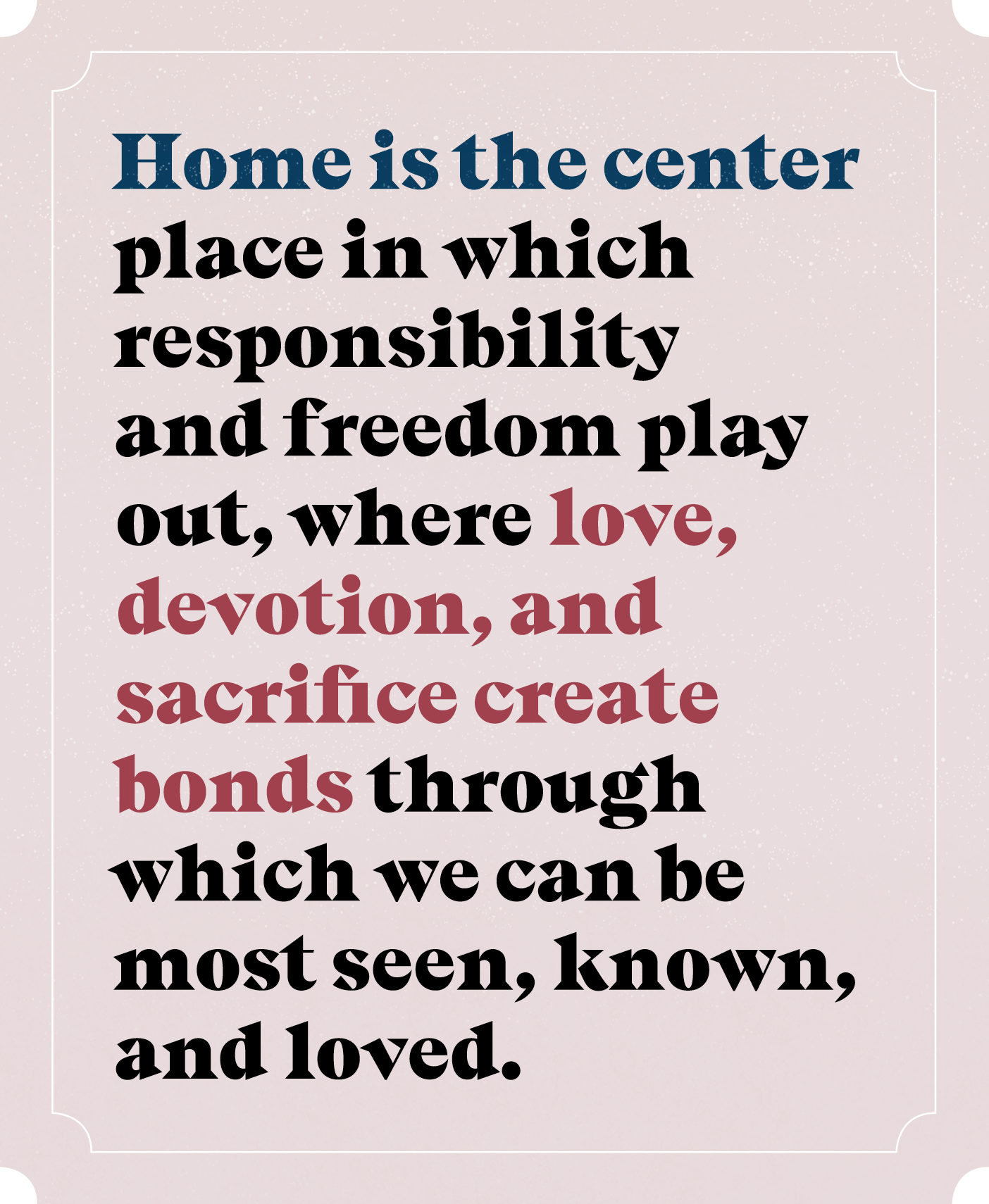
You have likely heard of the epidemic of loneliness, increase in mental-health challenges,17 and decrease in flourishing among adolescents and young adults.18 Individualism, workism, decreased marriage rates, diminished community engagement, declining religiosity, and social media all seem to have played a role, with the deepest loneliness stemming from disruption and disorder in family life.19 A culture focused on radical individualism has left us hungry.
As Terry A. Veling wrote in describing the profound insight of Emmanuel Levinas, “I am not an I unto myself, but an I standing before the other.”20 The presence of the other calls forth my response, making me at once a response-able being, calling me to attend, to listen, to serve. In fact, the autonomous, expressive individualist ideal shaping our culture has blinded us to the fact that the end purpose of agency is not the power to choose. It is freedom, the kind of freedom described powerfully by Dietrich Bonhoeffer: freedom to be “for the other”²¹—as our Redeemer was so majestically for us.
Home is the center place in which that responsibility and freedom play out, where love, devotion, and sacrifice create bonds through which we can be most seen, known, and loved. When U.S. surgeon general Vivek H. Murthy declared an epidemic of loneliness, he described it as feeling “homeless.”²² In his words, “To be at home is to be known.”²³
But as much as we yearn for this, it is not an easy process. It means intimacy—with all of its attendant fear of self-exposure, of being seen and known in all that we are and all that we are not. It means responsibility and profound trustworthiness so that others will be safe in our care. In our selfishness and fear of exposure, we struggle to experience the deep connection for which we yearn.
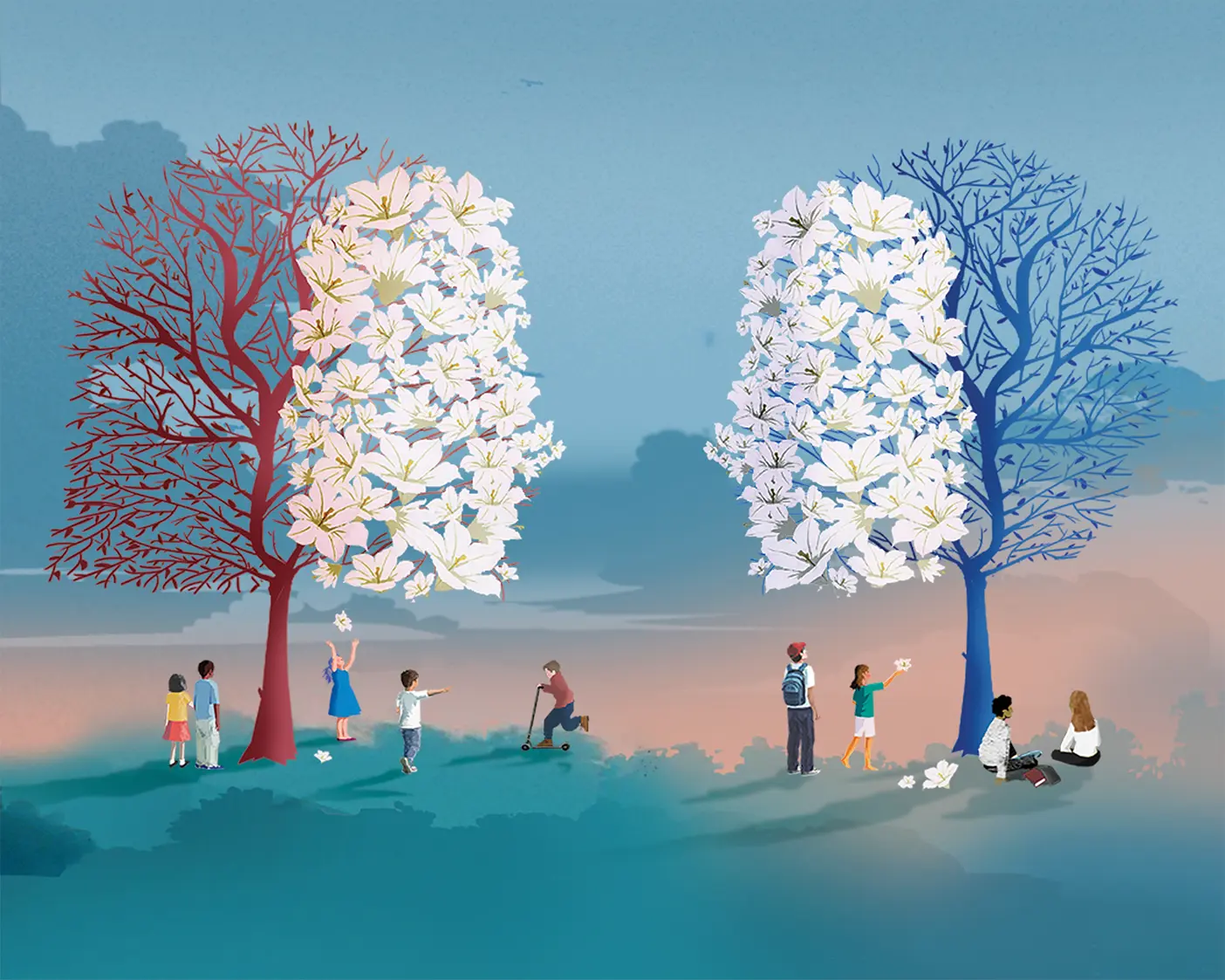
I did not become a mother until I was almost 35, after having studied motherhood for a decade. I yearned for a baby and the experience of rapturous love in nurturing another soul. But I found out quickly how inadequate and sometimes false my love could be, how I could use our little ones to validate myself. Like a powerful mirror they exposed my many weaknesses. Having a PhD in family science made my weaknesses seem even more pathetic.
It has been both enlightening and painful to see in myself our very human way of relating to others—seeking validation, selfishness, self-protection—blinding me from being able to actually see who others are, what they truly need, and what purity of love in doing what is best for them would look like.
I have come to realize that when my way of relating to my husband or children or any other is to use them for my own validation, to hide or separate or compare or compete, to position myself as somehow better or worse, I am trapped—unable to be truly free to see, to know, to love, or to be for the other.
Becoming Beings of Love
The whole work of the plan of salvation, culminating in the great atoning sacrifice of the Lord Jesus Christ, is to enable us to become beings of love in the deepest form of connection with others. The celestial sphere is a place of profound intimacy where we will “see as [we] are seen, and know as [we] are known, having received of his fulness and of his grace” (D&C 76:94).
This teaches us that commandments and all prophetic guidance— including the precious truths in the proclamation on the family24— are to guide us in the ways of God that we might become beings of love. Righteousness is never an end in itself. It is the quality of pure love, free of any design for self-protection or self-validation, offering that which is truly needed for the right reason: to help others become good.
But how do we become beings of such love? Experiencing such purity in relationships means being deeply grounded in who we are. And who is that? President Russell M. Nelson recently taught: “First and foremost, you are a child of God. . . . You are a child of the covenant. . . . You are a disciple of Jesus Christ.”25 Relationships, not autonomy, define our being. The divine nature of our heavenly parents is carried in the composition of our spiritual bodies. Their bond of love is at the core of our beings. Our eternal relationships are a material reality.
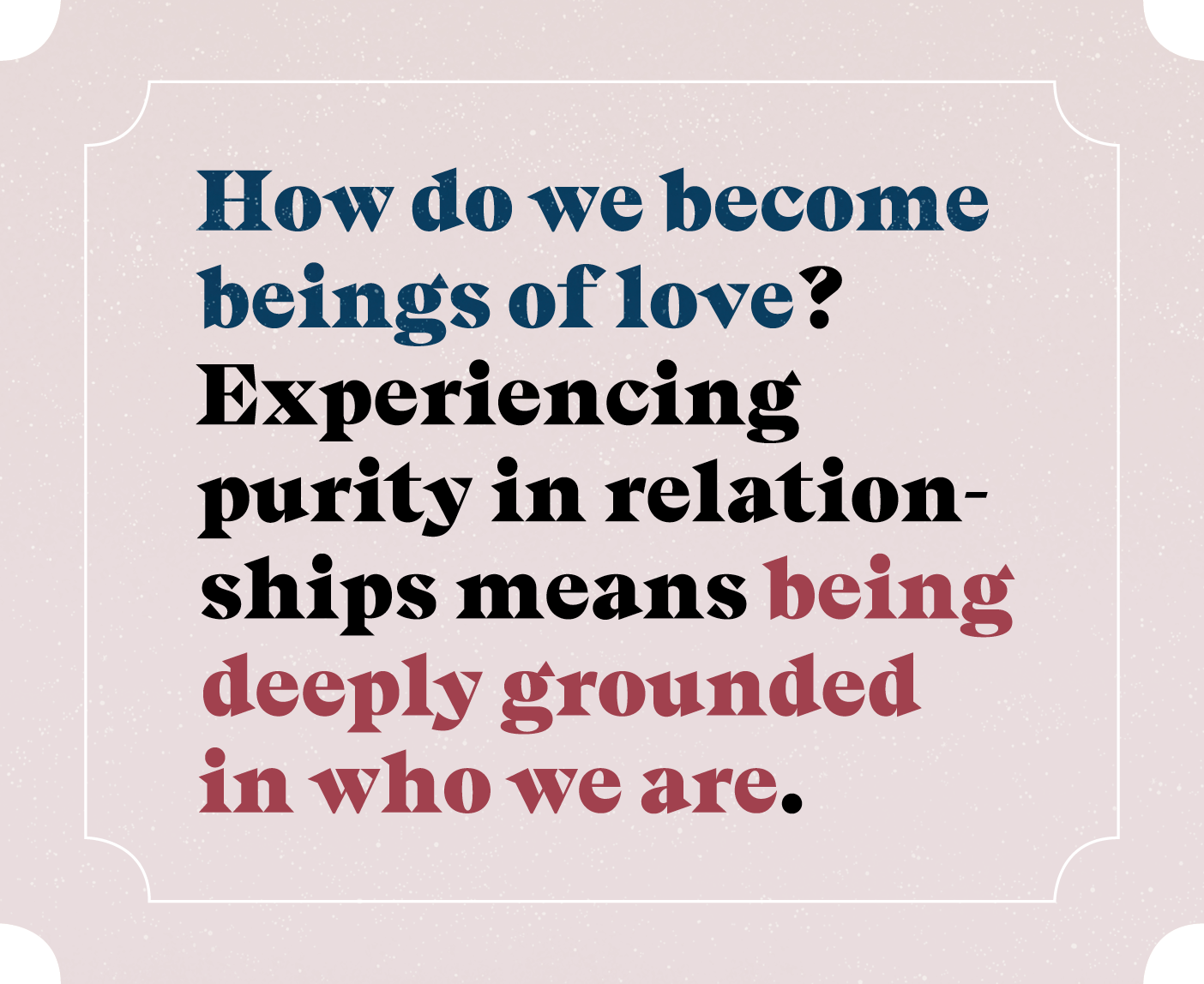
President Kevin J Worthen (BA ’79, JD ’82) testified of this reality: “Because we are [God’s] children, He will love us, even if we choose not to love Him.”26 Then, quoting Paul, President Worthen said, “Neither death, . . . nor height, nor depth, nor any other creature, shall be able to separate us from the love of God, which is in Christ Jesus our Lord” (Rom. 8:38–39).
In the powerful words of Catholic theologian and priest Henri J. M. Nouwen, “Being the Beloved expresses the core truth of our existence.”27 These words should “reverberate in every corner of [our] being . . . [for we] can give that gift only insofar as [we] have claimed it for [ourselves].”28 Nouwen continues:
The greatest trap in our life is not success, popularity, or power, but self-rejection. . . .
. . . Self-rejection is the greatest enemy of the spiritual life because it contradicts the sacred voice that calls us the “Beloved.”29
All sin is in some form a rejection of this relationship with God. It is no wonder that sin hurts. Sins committed against us, as well as sins that we commit, are a separation from the truth of our divine being.
In Adam S. Miller’s (BA ’01) words:
Sin is my rejection of God’s original offer of grace and partnership. . . . It’s me trying desperately to cobble together, through any means necessary . . . some bundle of good things that more closely matches what I wanted than what God gave. . . . It’s me choosing the hollow isolation of fantasies over the shared difficulty of God’s reality.30
Or as my friend Alan B. Hansen (BS ’91, MEd ’94, PhD ’04) describes in his work as a psychologist and in his service as president of a student stake, sin is the result of wounded souls trying to find their own way to manage pain apart from God.
I have learned that when the love of God is the foundation for my identity, I no longer need to pressure, coerce, judge, or extract validation from others in order to feel sufficient myself. I no longer need to prove myself worthy of God’s love, continually judging what I or others deserve. I am free to learn how to offer goodness, how to offer what is truly needed out of love.
Surely that is why President Worthen pled with us at the beginning of this school year:
Don’t be part of what would surely be the most tragic of all stories of unrequited love by refusing to feel the transformative, soul-changing love that God and Christ offer you. . . . Please, let Him love you.³¹
At One with God
The most powerful expression of God’s love is His offer to be in a covenant relationship with us. This is the purpose of the Abrahamic covenant. God is our Waymaker who yearns to be in a deep, binding relationship with us and is always making a way to life with Him: the Red Sea, His death on the cross, the rending of the veil—all of them cut through so He might be with us.³² He “cuts through every sin, every storm, every story, every sea . . . the whole way through for us, to be with us.”³³ In His becoming at-one with us, He opens the way for us to become at-one with Him. No wonder the transcendent promise of our first covenant is that we might always have His Spirit to be with us.
If there is anything studying family has taught me, it is that development emerges from within strong relationships. That is true from the beginning of our mortal experience, when, as infants, our first task is to establish a bond of deep emotional connection through which we can experience the love and responsiveness that build our brain, regulate our emotions, and establish our sense of identity and belonging.
In a parallel yet infinitely more profound way, covenants with God offer us the relationship through which our souls can grow, experience Him, and become beings who can see and know and love as He does, for we have experienced it in Him.
Our achievement-based, self-reliant culture may have taught us that we use the Atonement of Jesus Christ to achieve a “private, individual perfection”34—that those who are most righteous use the Atonement of Jesus Christ least. In that frame, as Adam Miller notes, “a covenant partnership with Christ will always look like a crutch that must be outgrown in order to achieve ‘real’ perfection.”35
But our covenant relationship with Jesus Christ is not the means to another end. It is the end. Sister Tracy Y. Browning powerfully witnessed: “Friends, Jesus Christ is both the purpose of our focus and the intent of our destination.”36
The Truest Intimacy
The Lord’s covenant relationship with us is the truest intimacy. It is the experience of perfect love with a Being who sees all that we are responsible for—in all our weakness and our sins—and reflects it back to us in the light of His purity, which expands our agency and leads us to a better way through His redeeming love. It is from the intimacy of our relationship with Him that we learn the path of intimacy, of pure love for others.
But in our pride, we want to put trust in our behaviors rather than in our relationship with Him, believing we can somehow save ourselves. As K. William Kautz poignantly writes, “[We] feign perfection even though the entire enterprise is a joke.”37 The Lord’s covenant relationship with us means a different way of living. “It requires the frightening joy of baring our entire soul—with all of its inadequacies. . . . The masks come off and the walls fall down.”38 In our honest willingness to show Him all of who we are, all of what we have done, and all of our motives and attitudes and desires, He covers us in tenderness and mercy. In that sacred relationship with Him, we find healing and freedom to be—for Him and for all others.
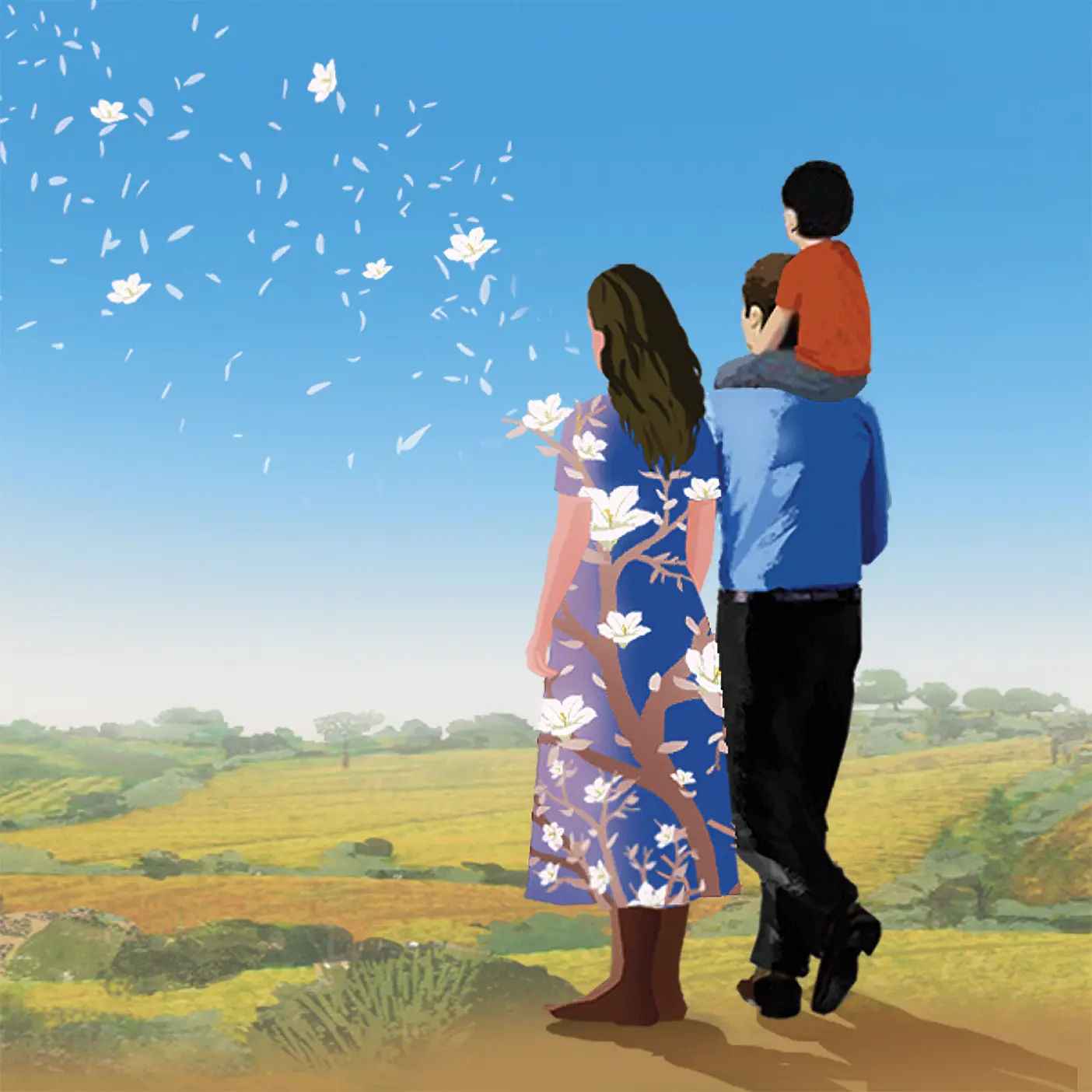
That is why Alan Hansen tells the members of his stake:
Our Redeemer says: “Come. Come. Come. Stop running from your nothingness. Bring all your frailties and mistakes and sins and sicknesses of soul and allow me to embrace you. Come.”
We fear that being single, never married, divorced, or infertile; struggling in marriage; having suffered abuse; wrestling with questions of gender or sexuality; or any other seeming difference from the ideal marks us as less worthy, second tier, not belonging. Instead, He says, “Come, share it all with me.”
He answers the pain and loss that is woven into the fabric of our mortal experience with the purest form of love—covenant love—entering into it with us. As the Hebrew word for sacrifice, korban, means, “He draws closer,” sharing our pain in the most profound form of intimacy and, in the process, rendering it redemptive.
Within His healing, guiding, purifying, strengthening covenant relationship, we learn that in our relationship with Him, as in relationships with all others, “perfection isn’t possible. Intimacy is.”39 In fact, intimacy with Christ is perfection. Our perfectionism— our fearing and hiding from our nothingness, weaknesses, sin, and suffering—only interferes with intimacy, blocking our ability to receive His love and to see, know, and love others.
Like the apostle Peter, we fear allowing the Lord to see and wash our muddy feet. But as Moroni taught, the only kind of perfection is perfection in Christ: “Yea, come unto Christ, and be perfected in him . . . , and love God with all your might, mind and strength . . . , that by his grace ye may be perfect in Christ” (Moro. 10:32). And so the great apostle Peter pled, “Lord, not my feet only, but also my hands and my head” (John 13:9).
Eternal Family
Christian writer Timothy J. Keller once wrote: “To be loved but not known is comforting but superficial. To be known and not loved is our greatest fear. But to be fully known and truly loved is, well, a lot like being loved by God.”40
This is the love God is calling us all into. We are deeply relational beings, designed for love and connection with God and with one another. Though our families fill a sacred role in the development and experience of this love, this is not where such love begins and ends. As my friend and colleague Ty R. Mansfield (BA ’04) powerfully teaches, we have been called into relationships with our eternal family—God’s family, which we are all a part of—so we might experience the Lord’s covenant healing, belonging, and redemption together in Him.
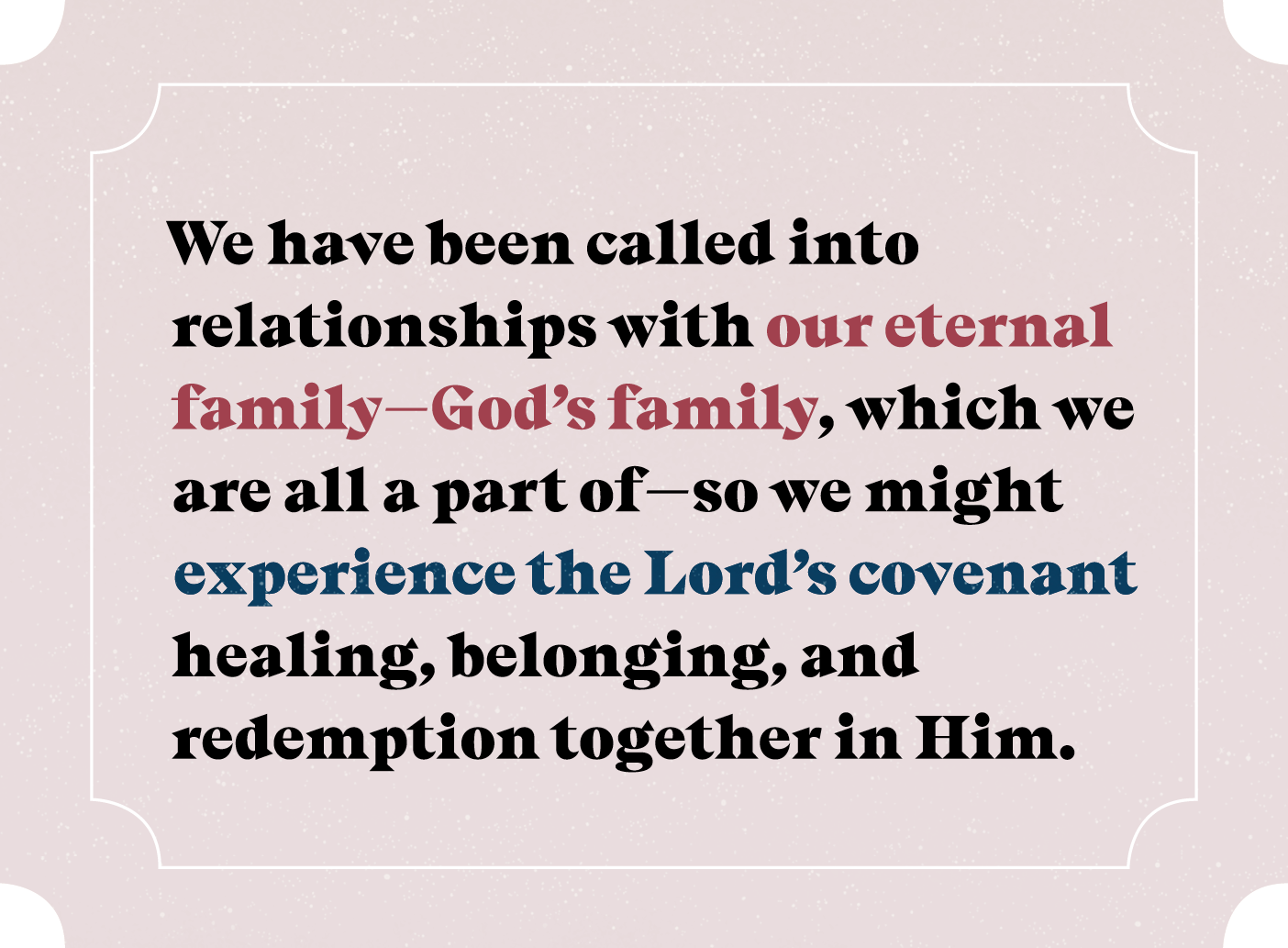
This is what we are doing when we stand in the place of eternal brothers and sisters and receive ordinances and make covenants in their behalf. This is what we are doing when we open our hearts to receive mission calls—not knowing where or how we may be called to serve, just knowing that we yearn to bless our eternal brothers and sisters with the opportunity for a covenant relationship with our Redeemer. This is why in our wards and stakes we seek to listen and to know, to love, and to strengthen one another in our covenant relationship with Christ: “For we without them cannot be made perfect; neither can they without us be made perfect” (D&C 128:18). We are an eternal family.
Our Redeemer stands before us, offering the most sacred prayer ever recorded:
That they all may be one; as thou, Father, art in me, and I in thee, that they also may be one in us. . . .
I in them, and thou in me, that they may be made perfect in one. [John 17:21, 23]
May we seek and experience this promise together with Him in our families and in our eternal family, eternally sealed together in relationships of divine love and belonging.
Feedback Send comments on this article to magazine@byu.edu.

Jenet Jacob Erickson, a BYU associate professor of Church history and doctrine, delivered this devotional address on Nov. 8, 2022. Find the full text, audio, and video at speeches.byu.edu.
NOTES
- W. Bradford Wilcox, “The New Progressive Argument: For Kids, Marriage Per Se Doesn’t Matter,” Institute for Family Studies blog, 15 September 2014, ifstudies.org/blog/for-kids-marriage-per-se-doesnt-matter-right.
- See W. Bradford Wilcox and Nicholas H. Wolfinger, “Men and Marriage: Debunking the Ball and Chain Myth,” Institute for Family Studies, research brief, February 2017, ifstudies.org/wp-content/uploads/2017/02/IFSMenandMarriageResearchBrief2.pdf.
- Zimmerman’s central thesis, as described by Allan C. Carlson, “Introduction to the 2008 Edition,” in Carle C. Zimmerman, Family and Civilization, ed. James Kurth (Wilmington, Delaware: ISI Books, 2008), ix; see also Carle C. Zimmerman, Family and Civilization (New York: Harper and Brothers, 1947).
- See Kathryn Edin and Maria Kefalas, Promises I Can Keep: Why Poor Women Put Motherhood Before Marriage (Berkeley: University of California Press, 2005).
- See Kathryn Edin and Timothy J. Nelson, Doing the Best I Can: Fatherhood in the Inner City (Berkeley: University of California Press, 2013).
- See Jenet Erickson, “Why Moms and Dads Both Matter in Marriage,” Public Discourse, 18 May 2015, thepublicdiscourse.com/2015/05/14962.
- Jeffrey R. Holland, “Of Souls, Symbols, and Sacraments,” BYU devotional address, 12 January 1988.
- See Report of the APA Task Force on the Sexualization of Girls, American Psychological Association, 2007, apa.org/pi/women/programs/girls/report.
- See Mark Regnerus, Cheap Sex: The Transformation of Men, Marriage, and Monogamy (New York: Oxford University Press, 2017).
- See Natasha Cabrera et al., “Rebalancing: Children First,” report of AEI-Brookings Working Group on Childhood in the United States, American Enterprise Institute and Brookings Institution, 8 February 2022, brookings.edu/research/rebalancing-children-first.
- See Kristin Anderson Moore, Susan M. Jekielek, and Carol Emig, “Marriage from a Child’s Perspective: How Does Family Structure Affect Children, and What Can We Do About It?” Child Trends, research brief, June 2002, childtrends.org/wp-content/uploads/2002/06/MarriageRB602.pdf.
- See Elizabeth Marquardt, Between Two Worlds: The Inner Lives of Children of Divorce (New York: Crown Publishers, 2005).
- See Antonio López, “The Child as the Guardian of Being,” in Torn Asunder: Children, the Myth of the Good Divorce, and the Recovery of Origins, ed. Margaret Harper McCarthy (Grand Rapids, Michigan: William B. Eerdmans, 2017), 105–30.
- Andy Crouch, The Life We’re Looking For: Reclaiming Relationship in a Technological World (New York: Convergent Books, 2022), 33. See Deuteronomy 6:5; Matthew 22:36–38; Mark 12:30; Luke 10:27.
- Crouch, The Life We’re Looking For, Ibid., p. 35.
- Crouch, The Life We’re Looking For, Ibid., p. 35.
- See Daniel Cox, “Growing Up Lonely: Generation Z,” Institute for Family Studies blog, 6 April 2022, ifstudies.org/blog/growing-up-lonely-generation-z.
- See Ying Chen et al., “National Data on Age Gradients in Well-Being Among U.S. Adults,”research letter, JAMA Psychiatry 79, no. 10 (October 2022): 1046–47; see also Tyler J. VanderWeele, “Why Young People’s Mental Well-Being Is in Such Decline . . . and a Possible Way Forward,” Human Flourishing (blog), Psychology Today, 25 August 2022, psychologytoday.com/us/blog/human-flourishing/202208/why-young-peoples-mental-well-being-is-in-such-decline.
- See Amber Lapp and David Lapp, “The Long Arm of Loneliness,” Institute for Family Studies blog, 19 January 2021, ifstudies.org/blog/the-long-arm-of-loneliness.
- Terry A. Veling, For You Alone: Emmanuel Levinas and the Answerable Life (Eugene, Oregon: Cascade Books, 2014), 36; emphasis in original.
- Dietrich Bonhoeffer, Creation and Fall: A Theological Interpretation of Genesis 1–3 (New York: Macmillan, 1959), 35.
- Vivek H. Murthy, Together: The Healing Power of Human Connection in a Sometimes Lonely World (New York: HarperCollins, 2020), xxii.
- Murthy, Together, xxii.
- See “The Family: A Proclamation to the World” (23 September 1995).
- Russell M. Nelson, “Choices for Eternity,” worldwide devotional for young adults, 15 May 2022; emphasis in original.
- Kevin J Worthen, “Choices for Eternity: Prophet ic Counsel,” BYU devotional address, 6 September 2022.
- Henri J. M. Nouwen, Life of the Beloved: Spiritual Living in a Secular World (New York: Crossroad Publishing, 1992), 33.
- Nouwen, Life of the Beloved, Ibid., p. 30.
- Nouwen, Life of the Beloved, Ibid., pp. 31, 33.
- Adam S. Miller, Original Grace: An Experiment in Restoration Thinking (Salt Lake City: Deseret Book; Provo: BYU Maxwell Institute, 2022), 83–84.
- Worthen, “Choices: Prophetic Counsel.”
- See Ann Voskamp, WayMaker: Finding the Way to the Life You’ve Always Dreamed Of (Nashville, Tennessee: Thomas Nelson, 2022), 218–19.
- Voskamp, WayMaker, Ibid., p. 219; emphasis in original.
- Miller, Original Grace, p. 22.
- Miller, Original Grace, Ibid., p. 87.
- Tracy Y. Browning, “Seeing More of Jesus Christ in Our Lives,”Liahona, November 2022; emphasis in original.
- K. William Kautz, Winter’s Grace: How Anguish and Intimacy Transform the Soul (Denver: Outskirts Press, 2012), 29.
- Kautz, Winter’s Grace, Ibid., pp. 28, 29.
- Kautz, Winter’s Grace, Ibid., p. 31.
- Timothy Keller and Kathy Keller, The Meaning of Marriage: Facing the Complexities of Commitment with the Wisdom of God (New York: Riverhead Books, 2011), p. 101.




